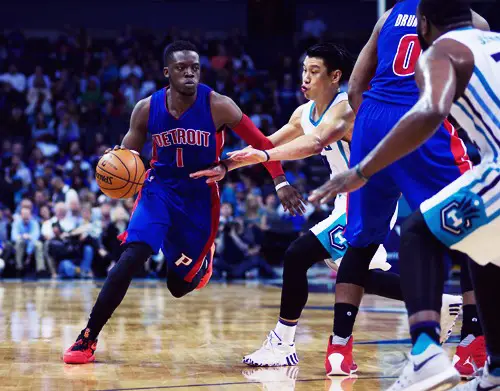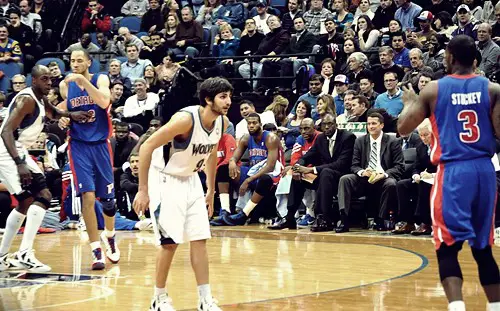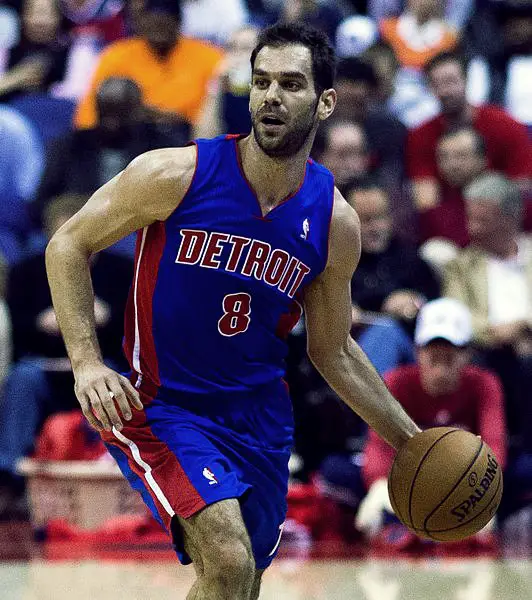
The Detroit Pistons, a celebrated establishment in the Public Ball Affiliation (NBA), have a rich history loaded up with important minutes and notorious players. While fans might be aware of their titles and striking players, there are less popular realities that add profundity to the group’s story. In this article, we will investigate ten captivating realities about the Detroit Pistons that could astound even the most committed fans.
Post Wayne Roots:
Prior to moving to Detroit in 1957, the Pistons were initially situated in Post Wayne, Indiana. They were known as the Stronghold Wayne Pistons and brought home two titles in 1944 and 1945 as a component of the Public Ball Association (NBL).
The “Awful Young men” Time:
The last part of the 1980s and mid 1990s denoted the period of the “Terrible Young men.” Drove by Isiah Thomas, Joe Dumars, and Bill Laimbeer, the Pistons fostered a harsh and actual style of play that drove them to consecutive NBA titles in 1989 and 1990.
The Notorious “Malignance at the Castle”:

The “Vindictiveness at the Castle” is a scandalous episode that happened on November 19, 2004, during a game between the Detroit Pistons and the Indiana Pacers at The Royal residence of Reddish-brown Slopes. The occurrence started when a fight broke out between the Pacers’ Ron Artest and the Pistons’ Ben Wallace, prompting a warmed squabble between players from the two groups. As strains heightened, a fan tossed a cup of pop at Artest, who then bounced into the stands to face the fan. This ignited a turbulent and phenomenal scene as players and fans became entangled in an out and out fight. The circumstance immediately spiraled wild, with punches tossed, objects flung, and an overall climate of bedlam and brutality. The occurrence brought about various suspensions and lawful ramifications for players included, discoloring the standing of the two groups and the association all in all. The “Vindictiveness at the Royal residence” was a huge defining moment in the NBA, provoking a reconsideration of safety efforts, fan conduct, and player-fan communications. It prompted stricter authorization of rules and guidelines to guarantee the security of players and observers. The occurrence likewise featured the requirement for impressive skill and restraint among players, as well as the obligation of fans to keep up with fitting behavior during games. The “Perniciousness at the Castle” stays a dull part in NBA history, filling in as a wake up call and a sign of the potential results when feelings heighten out of hand. In spite of the adverse consequence, the association gained significant illustrations from the occurrence and did whatever it takes to forestall comparative circumstances later on. The occasion likewise ignited conversations about the job of fans in sports and the significance of keeping a deferential and safe climate for all interested parties. While the “Noxiousness at the Castle” addresses a deplorable second for the Detroit Pistons and the NBA, it fills in as a sign of the requirement for sportsmanship, regard, and the consistent endeavors to guarantee the prosperity of players and fans the same.
The “Going to Work” Pistons:
The “Going to Work” Pistons time is a characterizing section throughout the entire existence of the Detroit Pistons. It alludes to the group’s personality and playing style during the mid 2000s, described by their relentless guard, magnanimity, and common hard working attitude. Driven by mentor Larry Brown, the Pistons embraced a group first mindset and zeroed in on smothering safeguard and aggregate exertion as opposed to depending on individual hotshots. The center of the group included players like Chauncey Billups, Richard Hamilton, Ben Wallace, Rasheed Wallace, and Tayshaun Sovereign. Together, they framed a strong unit that typified the embodiment of collaboration. The “Going to Work” Pistons were known for their stifling protection, frequently alluded to as the “Goin’ to Work” safeguard. They reliably positioned among the association’s best in guarded measurements, disappointing adversaries with their power, correspondence, and ability to forfeit individual brilliance to benefit the group. This obligation to guard turned into the group’s character and pushed them to progress. In 2004, the Pistons accomplished a definitive objective by coming out on top for the NBA title, overcoming the ritzy Los Angeles Lakers in a staggering upset. The triumph was a demonstration of their aggregate exertion, versatility, and immovable obligation to their protective standards. The “Going to Work” Pistons time made a permanent imprint on the establishment and the city of Detroit. The group’s workmanlike methodology resounded with the regular ethos of the city, procuring them the adoration and backing of fans. The “Going to Work” Pistons turned into a wellspring of motivation and pride for the local area, addressing the upsides of difficult work, durability, and constancy that Detroit is known for. While the group’s prosperity stretched out past the title season, their victory in 2004 remaining parts the zenith of their accomplishments. The “Going to Work” Pistons time remains as a demonstration of the force of collaboration, magnanimity, and a solid cautious mentality. It fills in as an update that an aggregate exertion, energized by commitment and solidarity, can beat individual ability and lead to significance. The tradition of the “Going to Work” Pistons lives on, valued by fans as an image of flexibility and the epitome of the genuine soul of Detroit ball.
The Longest Game in NBA History:

The Detroit Pistons were engaged with the longest game in NBA history, a long distance race challenge that occurred on December 13, 1983, against the Denver Chunks. The game endured an amazing triple-additional time, adding up to 63 minutes of playing time. The two groups struggled wildly all through the game, showing extraordinary perseverance and assurance. The Pistons, drove by Isiah Thomas and Kelly Tripucka, set forth some brave energy, while the Chunks, including players like Alex English and Kiki Vandeweghe, matched them step for step. The game was a high-scoring undertaking, with the two groups declining to withdraw. Many extra amounts of time, the players kept on stretching themselves to the edge, displaying their abilities and flexibility. The Pistons had numerous chances to get triumph, yet the Chunks figured out how to remain buzzing with grip shots and key cautious stops. As the game extended into triple-extra time, the players probably been actually and intellectually depleted, yet they proceeded to fight and contend at an inconceivably significant level. At long last, following 63 difficult minutes, the Pieces arose successful with a last score of 186-184. The game set various standards, remembering the most elevated consolidated score for a NBA game and the most focuses scored by a terrible group. It stays a famous crossroads in NBA history, displaying the unbelievable assurance and perseverance of the two groups. The Pistons’ contribution in the longest game in NBA history is a demonstration of their strength and never-surrender mentality. Regardless of the misfortune, the game exhibited the Pistons’ capacity to contend at the most significant level and drive their rivals to the edge. It additionally featured the extraordinary ability and expertise of the players in the two groups, who left everything on the court in quest for triumph. The longest game in NBA history will continuously be recognized as a demonstration of the coarseness and assurance of the Detroit Pistons and the Denver Chunks, as well as a recognition for the getting through soul of rivalry in the sport of b-ball.
The “Microwave” Epithet:
The “Microwave” moniker is inseparable from Vinnie Johnson, a central participant for the Detroit Pistons during their title runs in the last part of the 1980s. The epithet was given to Johnson by his partner, Isiah Thomas, who wondered about Johnson’s capacity to warm up rapidly and score in bundles off the seat. Very much like a microwave that quickly warms up food, Johnson had a talent for giving a moment hostile flash to the Pistons. His scoring skill and grasp exhibitions procured him a standing as one of the most mind-blowing 6th men in NBA history. Johnson’s capacity to fall off the seat and quickly have an effect was priceless for the Pistons, furnishing them with a dependable scoring choice and empowering the group when they required it most. His capacity to score in bundles, particularly during essential snapshots of the game, gained him the appreciation and esteem of his colleagues and fans the same. Johnson’s microwave-like scoring skill was on full showcase during the Pistons’ title runs in 1989 and 1990, where he assumed a critical part in getting triumphs. His skill for hitting ideal shots and conveying in pressure circumstances procured him a spot in Pistons legend.
The “Microwave” moniker mirrored Johnson’s hostile ability as well as featured his capacity to change the game’s elements in a moment. In spite of his generally humble height, Johnson’s speed, deftness, and scoring impulses made him an impressive power on the court. Indeed, even rivals perceived his effect, as they probably were aware that when the “Microwave” got hot, it was trying to contain his scoring flood. Johnson’s epithet has endured for an extremely long period and stays a dearest part of the Pistons’ set of experiences. It fills in as a sign of his remarkable playing style and the critical job he played in the group’s prosperity. The “Microwave” epithet exemplifies Johnson’s capacity to warm up the game and leave an enduring effect, making him a fundamental figure in the celebrated history of the Detroit Pistons.
The Primary Group to Take down the Fantasy Group:
The Detroit Pistons hold a one of a kind qualification as the primary group to overcome the unbelievable “Dream Group” during a show game in 1992. The Fantasy Group, made out of NBA hotshots like Michael Jordan, Sorcery Johnson, Larry Bird, and other ball symbols, was framed to address the US in the Late spring Olympics held in Barcelona. The group was generally viewed as one of the best b-ball gatherings ever, with an unmatched degree of ability and expertise. Be that as it may, in a shocking steamed, the Pistons figured out how to overcome the Fantasy Group in a pre-Olympic display game, exhibiting their considerable ability and cutthroat soul. The triumph was a demonstration of the Pistons’ famous “Terrible Young men” safeguard, which was secured by players like Isiah Thomas, Joe Dumars, and Dennis Rodman. Their actual style of play, combined with their capacity to disturb rivals’ hostile stream, ended up being quite difficult for the ritzy Dream Group. The Pistons’ triumph over the Fantasy Group was a huge crossroads in b-ball history, as it demonstrated the way that even the most prevailing assortment of players could be crushed still up in the air and firm group. The success featured the Pistons’ ability and solidified their heritage as one of the best groups of their period. While the show game didn’t combine with true records, it stays a noteworthy and celebrated accomplishment for the Pistons and their fans. The triumph exhibited the significance of cooperation, guarded power, and vital execution, demonstrating that b-ball is a game where anything can occur on some random day. The Pistons’ victory over the Fantasy Group is a demonstration of the erratic idea of sports and the persevering through tradition of a group that carved its name in history by overcoming b-ball’s most notorious crew.
The “Engine City” Association:
The “Engine City” association is a necessary piece of the personality and culture of the Detroit Pistons. It addresses serious areas of strength for the between the group and the city of Detroit, which is frequently alluded to as the “Engine City” because of its memorable noticeable quality in the auto business. The Pistons have embraced this association and have turned into an image of versatility, difficult work, and assurance, very much like the city they address. The epithet “Engine City” means the common hard working attitude that both the group and the city typify. The Pistons have a long history of progress, portrayed by their determined safeguard, collaboration, and durability, reflecting the soul of the diligent individuals of Detroit. The group’s relationship with the city’s modern legacy is clear in their logo, which includes a ball being held by a cylinder, a sign of approval for the car business. The “Engine City” association goes past imagery; it addresses the common qualities and pride between the group and the local area. The Pistons have been a wellspring of motivation and expectation for the city, especially during testing times. The group’s strength and capacity to beat misfortune resound with the city’s own battles and assurance to reconstruct and flourish. The energetic fan base of the Pistons mirrors the steadfast help and unwaveringness of the Detroit people group. Home games at the Little Caesars Field are loaded up with fiery serenades, displaying areas of strength for the between the group and its fans. The “Engine City” association is a wellspring of inspiration for the players, who comprehend the meaning of addressing the city and its kin. It fills in as a steady suggestion to do their absolute best on the court and take a stab at greatness. The Pistons effectively draw in with the local area through different drives, supporting nearby causes and having a beneficial outcome past the b-ball court. This association between the Pistons and the “Engine City” is a demonstration of the getting through connection between a group and its local area, joined by shared values, strength, and a well established love for the sport of b-ball.
The Steady Rebounder:
Dennis Rodman, the steady rebounder, had a permanent effect on the Detroit Pistons during his residency with the group from 1986 to 1993. Known for his relentless guard, unparalleled bouncing back abilities, and ostentatious character, Rodman turned into a critical figure in the Pistons’ prosperity. Remaining at 6 feet 7 inches tall, Rodman’s capacity to outperform adversaries on the sheets was unmatched. He had an inborn feeling of timing, situating, and steady quest for the b-ball, which acquired him various honors. Rodman drove the association in bounce back per game for seven sequential seasons from 1991 to 1998, a momentous accomplishment that set his standing as one of the best rebounders in NBA history. His bouncing back ability was instrumental in the Pistons’ cautious character, giving additional belongings to the group while baffling adversaries. Rodman’s commitment to bouncing back went past his actual capacities. He concentrated on rivals’ shooting inclinations, situating himself decisively to expect missed shots and secure bounce back. His power and hustle on the court empowered his colleagues and turned into a sign of the Pistons’ playing style. Rodman’s bouncing back ability arrived at its top during the “Terrible Young men” period, in which the Pistons brought home consecutive NBA titles in 1989 and 1990. His commitments on the glass were instrumental in the group’s prosperity, supplementing the guarded ability of players like Isiah Thomas, Joe Dumars, and Bill Laimbeer. Off the court, Rodman’s erratic character and novel style decisions made him an amazing figure. Regardless of his unpredictable persona, his hard working attitude and obligation to his art were obvious. Rodman’s tenacious bouncing back and cautious abilities left a getting through heritage in the Detroit Pistons’ set of experiences. His effect stretched out past the detail sheet, as he exemplified the group’s regular hard working attitude and abrasive playing style. Today, Rodman is recognized as one of the best rebounders in NBA history and a vital supporter of the Pistons’ prosperity during quite possibly of their most significant period.
The Greenish blue Regalia:
The Detroit Pistons’ blue-green outfits hold a novel spot in the group’s set of experiences, addressing a brief yet noteworthy time during the 1990s. Presented in 1996, these dynamic regalia planned to modernize the group’s picture and encapsulate the times. The shift to greenish blue was a takeoff from the conventional red, white, and blue variety plot that had for quite some time been related with the Pistons. The choice to embrace blue-green was affected by the developing notoriety of the variety in sports design during that period. The blue-green garbs highlighted strong plan components, including inclination examples and unique shapes. The group’s logo was refreshed to integrate the greenish blue tone, giving it a new and contemporary look. While the greenish blue regalia were met with blended responses from fans, they certainly left an enduring effect on the Pistons’ visual personality. They became inseparable from a specific time in the group’s set of experiences, when players like Award Slope, Jerry Stackhouse, and Joe Dumars graced the court. Regardless of their generally short life expectancy, the greenish blue regalia became notable and are frequently connected with the time of ball that characterized the mid-1990s. Today, these pullovers are valued by fans and gatherers the same, filling in as a nostalgic sign of an extraordinary part in the Detroit Pistons’ excursion. Whether cherished or despised, the blue-green garbs are a demonstration of the group’s readiness to embrace change and examination with its visual portrayal. While they have since gotten back to their customary variety plot, the greenish blue regalia stay a brilliant and unmistakable piece of the Pistons’ heritage, everlastingly carved in the recollections of ball fans.
End:
The Detroit Pistons have made a permanent imprint on the NBA with their title runs, special playing styles, and critical minutes. Investigating these less popular realities adds profundity to the group’s set of experiences and exhibits the rich embroidered artwork of the establishment. From their initial days in Stronghold Wayne to the “Terrible Young men” time and then some, the Pistons keep on dazzling fans with their versatility and commitment to addressing the Engine City.

